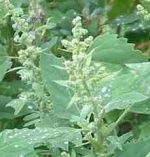 Lamb’s quarters is a summer annual and member of the amaranth family, Amaranthaceae, that also includes beet, spinach, and cock’s comb. It is native to Europe and Asia , possibly North America, but is widely introduced elsewhere. Throughout the US lamb’s quarters grows in areas with full sun and medium moist, fertile soil, and can be found in gardens , croplands, old fields, vacant lots, and waste area. Although it is extensively cultivated in India as a food crop, it is considered a weed in the US and contributes to significant crop loss especially of corn, soybean, and sugar beet.
Lamb’s quarters is a summer annual and member of the amaranth family, Amaranthaceae, that also includes beet, spinach, and cock’s comb. It is native to Europe and Asia , possibly North America, but is widely introduced elsewhere. Throughout the US lamb’s quarters grows in areas with full sun and medium moist, fertile soil, and can be found in gardens , croplands, old fields, vacant lots, and waste area. Although it is extensively cultivated in India as a food crop, it is considered a weed in the US and contributes to significant crop loss especially of corn, soybean, and sugar beet.
Description: The fast growing plants arise from a stout taproot and are bushy, pyramidal, and up to six feet tall. They have upright branching stems that often have green or reddish grooves along their length. The oval to triangular leaves are up to five inches long and have toothed margins and a mealy coating on their underside. The small yellowish green flowers are apetalous and appear in panicles of spikes usually four inches long in the leaf axils and terminal tips of the branches from early summer to fall. Flowers give way to round, black, flattened achenes containing one seed; a single plant can produce over 50,000 seeds that may be viable for up to thirty years. Plants spread by seeds.
Control: Mulch to prevent existing seeds from sprouting; pull or hoe small plants before they set seed. In severe cases pre-emergence herbicides, such as Preen, and post-emergent herbicides such as Trimec, may be options.